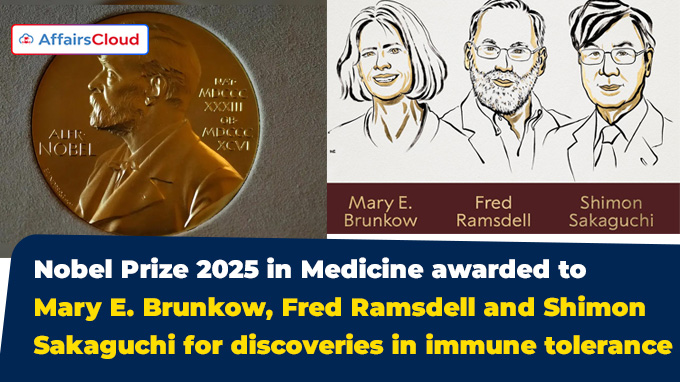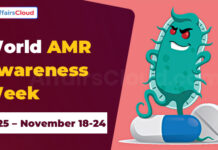On October 6, 2025, Shimon Sakaguchi, a Japanese Immunologist, Mary E. Brunkow, an American molecular biologist and immunologist, Fred Ramsdell, an American immunologist, are declared as the winners of Nobel Prize in Physiology or Medicine 2025 by the Nobel Assembly at Karolinska Institutet in Stockholm, Sweden.
- They are recognized for their discoveries concerning peripheral immune tolerance that prevents the immune system from harming the body.
Exam Hints:
- What? Nobel Prize in Physiology or Medicine 2025 announced
- Who? The Nobel Assembly at Karolinska Institutet in Stockholm (Sweden)
- Laureates: Shimon Sakaguchi, Mary E. Brunkow, Fred Ramsdell
- Prize Components: Gold medal, diploma, and 11 million SEK cash (2025)
- Recognition: For their discoveries concerning peripheral immune tolerance
- Key Discoveries:Regulatory T Cells (Tregs), FOXP3 Gene and FOXP3 in Humans
- Number of Awards & Laureates (1901–2025): 116 prizes, 232 individuals
- 2024 Laureates: Victor Ambros & Gary Bruce Ruvkun – joint award
About Nobel Prize in Physiology or Medicine:
Presentation Ceremony: Nobel Prizes will be presented annually to laureates on 10th December, commemorating the anniversary of Alfred Nobel’s death.
Medal: It was designed by Swedish sculptor and engraver Erik Lindberg, depicts Genius of Medicine holding an open book in her lap, collecting the water pouring out from a rock to quench a girl’s thirst.
- It is inscribed with “Inventas vitam iuvat excoluisse per artes”, which means “It is beneficial to have improved (human) life through discovered arts”.
Key Discoveries:
Regulatory T Cells: In 1995, Shimon Sagakuchi identified a subset of T cells that suppress immune responses, preventing autoimmune diseases. He termed these cells as regulatory T cells (Tregs).
- His work demonstrated that the immune system has a mechanism to control itself, ensuring it doesn’t attack the body’s own tissues.
FOXP3 Gene: In 2001, Brunkow discovered that mutations in the FOXP3 gene led to a fatal autoimmune disease in mice. She found that FOXP3(scurfin) is essential for the development and function of Tregs.
- The role of FOXP3 was later confirmed in humans with Immune dysregulation, Polyendocrinopathy, Enteropathy, X-linked (IPEX) syndrome, a rare-autoimmune disorder.
Link of FOXP3 to Human Disease: The research by Ramsdell connected the FOXP3 gene to human autoimmune disease. He demonstrated that mutations in FOXP3 disrupt Treg function, leading to conditions such as IPEX syndrome, bridging the gap between basic science and clinical applications.
Winners of Nobel Prize in Physiology or Medicine 2025:
| Nobel Laureate | Awarded for |
|---|---|
| Shimon Sagakuchi | For their discoveries concerning peripheral immune tolerance that prevents the immune system from harming the body |
| Mary E. Brunkow | |
| Fred Ramsdell |
About Winners:
Shimon Sagakuchi: He is a distinguished Professor at the Immunology Frontier Research Centre (IFReC), a part of Osaka University in Suita (Japan). He leads the Experimental Immunology Laboratory, focusing on immune regulation and the role of Tregs in maintaining tolerance and preventing immune diseases.
Mary E. Brunkow: He is a Senior Program Manager at the Institute for Systems Biology (ISB) at Seattle in Washington, United States of America (USA). He has been involved in several collaborative research initiatives, including studies on family genomics, Lyme disease, sepsis biomarkers, and scientific wellness.
Fred Ramsdell: He is a Scientific Advisor and co-founder of Sonoma Biotherapeutics, a biotechnology company, in San Francisco (USA), focusing on developing Treg-based treatments for autoimmune diseases, including rheumatoid arthritis and hidradenitis suppurativa, which are under clinical trials.
Scientific Background:
Immune System: The human immune system defends the body against infections and cancer by differentiating self (body’s own cells) and non-self (pathogens or abnormal) cells. When this system malfunctions, it can result in autoimmune diseases, such as Type 1 diabetes, rheumatoid arthritis, or multiple sclerosis.
Tolerance: Immune tolerance operates at two primary levels such as Central Tolerance, occurring in the thymus, eliminating self-reactive immune cells at the early stages and preventing them from entering the circulation.
- It also includes Peripheral Tolerance, occurring in the body’s tissues, functioning as a secondary safeguard, suppressing any self-reactive immune cells that escape central tolerance.
Key Facts of Nobel Prize in Physiology or Medicine:
Number of Awards & Laureates: 116 Nobel Prizes in Physiology or Medicine have been awarded to 232 individuals between 1901 and 2025.
- 40 of those prizes were awarded to a single laureate, 36 were shared between two laureates, and 40 were shared among three laureates.
Gender Among Laureates: Among the 232 laureates, 13 are women. Barbara McClintock is the only woman to have received an unshared Nobel Prize in Physiology or Medicine.
Years Without an Award: The Nobel Prize in Physiology or Medicine was not awarded on nine occasions: 1915, 1916, 1917, 1918, 1921, 1925, 1940, 1941, and 1942.
Youngest Laureate: Frederick G. Banting was awarded the Nobel Prize at the age of 31 for the discovery of insulin.
Oldest Laureate: Peyton Rous received the Nobel Prize at the age of 87 for his discovery of tumour-inducing viruses.
First Woman Laureate: Gerty Theresa Cori became the first woman to receive the Nobel Prize in Physiology or Medicine. She, along with her husband Carl Ferdinand Cori, was honoured in 1947 for discovering the course of the catalytic conversion of glycogen.
2024 Nobel Laureates in Physiology or Medicine: Victor Ambros, an American developmental biologist, and Gary Bruce Ruvkun, an American molecular biologist, were jointly awarded the Nobel Prize in Physiology or Medicine in 2024.
About the Nobel Prize:
International Recognition: The Nobel Prize is a prestigious global award administered by the Nobel Foundation in Stockholm, Sweden, honouring remarkable discoveries and achievements that contribute to the betterment of humanity.
Origin : The prize is funded by the fortune of Alfred Nobel, the Swedish inventor and entrepreneur best known for inventing dynamite.
Fields of Award: Since its inception in 1901, the Nobel Prize has been conferred in the fields of Physics, Chemistry, Physiology or Medicine, Literature, and Peace.
- In 1968, Sveriges Riksbank (Sweden’s Central Bank) established the Sveriges Riksbank Prize in Economic Sciences in Memory of Alfred Nobel, expanding the Nobel legacy.
Prize Money:
- Award Components: Each Nobel Prize laureate receives a gold medal, a personal diploma, and a cash prize.
- Monetary Value: For 2025, the cash award for a full Nobel Prize was set at 11 million Swedish kronor (SEK).
Click here for more information about the Nobel Prize
About Nobel Assembly:
Chair – Astrid Soderbergh Widding
Headquarters – Stockholm, Sweden
Established – 1977





